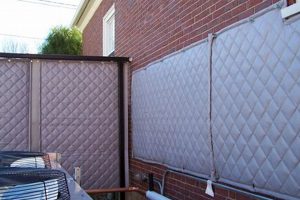Creating personalized markers for exterior spaces through do-it-yourself methods encompasses a range of activities, from selecting materials and designing layouts to the physical construction and finishing of the piece. Examples include crafting a wooden address plaque for a residence, fashioning a decorative welcome sign for a garden gate, or producing informative labels for plants and herbs. The core principle is independent fabrication, circumventing the need for professional services.
The value of this undertaking lies in its ability to provide customized solutions tailored to individual aesthetic preferences and functional needs, frequently at a reduced cost compared to commercial alternatives. Historically, handcrafted signage represented a prevalent means of identification and communication, particularly in rural communities and small businesses. This practice reflects a tradition of resourcefulness and artistic expression.
The subsequent discussion will delve into the selection of appropriate materials, outline essential techniques for design and construction, and explore various finishing options to ensure durability and visual appeal for these projects. This guidance aims to empower individuals to confidently produce effective and aesthetically pleasing markers for their outdoor environments.
Essential Considerations for Exterior Signage Fabrication
Achieving durable and aesthetically pleasing results in self-directed outdoor marker creation requires careful planning and execution. The following points emphasize critical aspects for successful projects.
Tip 1: Material Selection: Prioritize weather-resistant materials. Untreated wood is susceptible to rot and insect damage. Opt for cedar, redwood, or treated lumber. Metal choices should include aluminum or stainless steel to prevent rust. Plastics, such as acrylic or PVC, offer durability and versatility.
Tip 2: Design Clarity and Legibility: Ensure the design is easily readable from the intended viewing distance. Employ clear, sans-serif fonts for optimal legibility. Contrast between the lettering and background is paramount. Consider letter size in relation to viewing distance.
Tip 3: Secure Mounting: Implement a robust mounting system suitable for the sign’s size and weight, and the substrate to which it will be affixed. For wood posts, use galvanized screws or bolts. For masonry, employ appropriate anchors and fasteners. Ensure the mounting system can withstand anticipated wind loads.
Tip 4: Protective Finishes: Apply appropriate finishes to safeguard the sign from environmental degradation. Exterior-grade paints and sealants provide protection against moisture, UV radiation, and abrasion. Consider multiple coats for enhanced durability. Regular maintenance, including cleaning and re-application of finishes, extends the sign’s lifespan.
Tip 5: Consider Local Regulations: Before commencing a project, research any applicable municipal regulations regarding signage, including size restrictions, placement guidelines, and permit requirements. Failure to comply may result in fines or removal orders.
Tip 6: Template Use: Use templates to ensure that the letter is uniform and properly aligned for better looking.
Tip 7: Illumination: To add a touch of elegance, add lights with warm tone to make it visible even at night.
These guidelines enhance the longevity, functionality, and visual appeal of self-made external markers. Diligent adherence to these principles contributes to a professional and lasting outcome.
The subsequent sections will explore specific techniques for various material types and design styles.
1. Material Weather-Resistance
Material weather-resistance constitutes a cornerstone of successful do-it-yourself exterior marker creation. The ability of selected components to withstand environmental factors directly impacts the lifespan, appearance, and overall effectiveness of the finished product. Careful consideration of material properties is therefore paramount.
- Selection of Wood Species
The choice of wood species fundamentally determines a sign’s resilience to moisture, decay, and insect infestation. Options like cedar, redwood, and pressure-treated lumber inherently possess greater resistance compared to untreated pine or fir. In environments with high humidity or frequent rainfall, utilizing these weather-resistant woods is crucial for preventing warping, cracking, and rot. The initial investment in these materials offsets the cost of premature replacement or repairs.
- Metal Corrosion Prevention
When incorporating metallic elements into a do-it-yourself external marker, addressing the potential for corrosion is essential. Iron and steel, without protective coatings, are susceptible to rust when exposed to moisture and oxygen. Aluminum and stainless steel offer superior corrosion resistance and are often preferred choices for frames, fasteners, and decorative accents. Applying protective coatings such as powder coating or galvanization to ferrous metals provides an additional barrier against environmental degradation.
- Protective Finishes and Sealants
Irrespective of the inherent weather resistance of the base material, the application of appropriate finishes and sealants is vital for long-term protection. Exterior-grade paints, stains, and varnishes form a barrier against UV radiation, moisture penetration, and temperature fluctuations. Sealants applied to joints and seams prevent water ingress, mitigating the risk of rot and corrosion. Regular maintenance, including periodic reapplication of finishes, is necessary to maintain the protective barrier.
- Plastic and Composite Material Durability
The utilization of plastics and composite materials in do-it-yourself outdoor signage offers inherent advantages in terms of weather resistance. Materials like PVC, acrylic, and high-density polyethylene (HDPE) are impervious to moisture, resistant to UV degradation, and immune to insect infestation. These materials are particularly well-suited for applications where dimensional stability and low maintenance are critical. However, it is important to select plastics with appropriate UV stabilizers to prevent discoloration or embrittlement over time.
The careful selection and treatment of materials to enhance weather resistance directly correlates with the longevity and aesthetic appeal of do-it-yourself outdoor markers. By prioritizing durable components and implementing appropriate protective measures, individuals can create signage that withstands the elements and effectively serves its intended purpose for years to come.
2. Design Legibility
Design legibility is a critical element in the successful creation and implementation of do-it-yourself external markers. The primary function of such a marker is to convey information effectively, and illegible signage fails to achieve this purpose, irrespective of aesthetic considerations. Poor font choices, insufficient contrast, and inadequate letter sizing can render the marker useless. For example, a house number rendered in a thin, ornate font against a similarly colored background is significantly less effective than a larger, sans-serif number with high contrast. The former necessitates close proximity and focused attention for decipherment, while the latter is easily discernible from a distance, fulfilling its intended function of identification. Legibility directly impacts the marker’s utility.
The integration of clear design principles extends beyond mere font selection and contrast. Letter spacing, line height, and the overall arrangement of textual elements contribute to the ease with which information is processed. Cluttered designs with excessively dense text diminish legibility, particularly when viewed from a moving vehicle or in low-light conditions. A well-designed marker employs a hierarchical structure, prioritizing key information and employing visual cues to guide the viewer’s eye. Consider the common practice of using larger, bolder text for primary identifiers (e.g., street names) and smaller, less prominent text for secondary details (e.g., suite numbers). This strategic use of visual hierarchy enhances comprehension and facilitates rapid information retrieval.
In conclusion, the effectiveness of a do-it-yourself outdoor marker is fundamentally contingent upon its design legibility. While aesthetic considerations are important, they should not supersede the primary goal of clear communication. Challenges in achieving optimal legibility often arise from inadequate planning, insufficient attention to detail, and a lack of understanding of basic design principles. Prioritizing legibility through careful font selection, contrast management, and strategic layout design ensures that the marker effectively serves its intended purpose, thereby maximizing its functional and visual impact.
3. Secure Mounting
Secure mounting is paramount for the longevity and safety of any self-constructed exterior marker. The effectiveness of the sign in conveying its intended message is irrelevant if it is dislodged by wind, vandalism, or material failure. This section outlines critical considerations for achieving robust and durable installation.
- Selection of Appropriate Fasteners
The choice of fasteners must align with both the sign material and the substrate to which it is affixed. Galvanized or stainless steel screws are appropriate for wood, while masonry anchors are necessary for brick or concrete. Selecting the wrong type or size of fastener can lead to premature failure. Overly long screws can compromise the structural integrity of wood, while inadequately sized anchors will not provide sufficient holding power in masonry. Fastener selection should also consider the anticipated load and environmental conditions.
- Consideration of Wind Load
Outdoor signs are subject to wind loads, which can exert significant force, especially on larger signs. Mounting systems must be designed to withstand these forces. This may involve using multiple attachment points, employing larger diameter fasteners, or utilizing bracing to distribute the load. The size, shape, and location of the sign all influence the magnitude of the wind load it will experience. Consulting local building codes or engineering guidelines may be necessary for signs in high-wind areas.
- Prevention of Corrosion
Corrosion can weaken fasteners and mounting hardware over time, leading to failure. Using corrosion-resistant materials, such as stainless steel or hot-dipped galvanized steel, is essential. In coastal environments or areas with high levels of air pollution, the risk of corrosion is particularly high. Applying protective coatings or sealants to fasteners can provide an additional barrier against corrosion. Regular inspection and maintenance of the mounting system are also important for detecting and addressing any signs of corrosion.
- Proper Installation Techniques
Even with the correct materials, improper installation can compromise the security of the mounting system. Drill pilot holes to prevent wood from splitting, use the correct size drill bit for masonry anchors, and ensure that all fasteners are tightened to the appropriate torque. Over-tightening can strip threads or damage the substrate, while under-tightening can result in loosening over time. Following manufacturer’s instructions for installation is crucial for achieving a secure and reliable mount.
These facets of secure mounting directly affect the long-term stability and safety of do-it-yourself external markers. Implementing appropriate practices ensures that signs remain firmly in place, effectively fulfilling their intended purpose and minimizing the risk of damage or injury.
4. Protective Finishing
Protective finishing constitutes a critical phase in the fabrication of do-it-yourself external markers, directly influencing their longevity and resistance to environmental degradation. Without appropriate surface treatments, even the most carefully constructed marker will succumb to weathering, leading to diminished aesthetic appeal and potential structural failure. The implementation of suitable finishing techniques is therefore essential for preserving the integrity and functionality of these items.
- Moisture Resistance and Sealants
The application of moisture-resistant coatings is paramount for protecting wood-based markers from rot, warping, and cracking. Penetrating sealants, such as oil-based stains or marine-grade varnishes, impregnate the wood fibers, creating a barrier against water ingress. These coatings prevent moisture from entering the wood, thereby inhibiting the growth of fungi and bacteria that cause decay. In regions with high humidity or frequent rainfall, the use of effective sealants is particularly critical. An example is using spar urethane on a cedar address sign to withstand coastal weather conditions.
- UV Protection and Pigmentation
Exposure to ultraviolet (UV) radiation from sunlight causes fading, discoloration, and embrittlement of many materials used in outdoor markers, including wood, plastics, and even some metals. Pigmented finishes, such as exterior-grade paints and stains, incorporate UV absorbers that mitigate the damaging effects of sunlight. Darker colors generally provide better UV protection than lighter colors. Additionally, clear topcoats containing UV inhibitors can be applied over painted or stained surfaces to provide an extra layer of protection. A practical example is using a UV-resistant clear coat on a painted acrylic garden sign to prevent fading.
- Corrosion Inhibition for Metals
Metallic components of outdoor markers are susceptible to corrosion, particularly in environments with high salinity or air pollution. Protective finishes, such as powder coating, galvanizing, or the application of anti-corrosion primers, create a barrier between the metal surface and the corrosive elements. These finishes prevent oxidation and other chemical reactions that lead to rust and degradation. An example includes powder-coating steel sign frames used in commercial settings for enhanced durability.
- Abrasion Resistance and Durability
Outdoor markers are often subjected to abrasion from windborne particles, physical contact, and cleaning activities. Protective finishes can enhance the surface hardness and scratch resistance of the marker, thereby prolonging its lifespan. Two-part epoxy coatings, for example, provide a durable, abrasion-resistant finish suitable for high-traffic areas. Regular cleaning and maintenance, including the reapplication of protective finishes as needed, are essential for preserving the appearance and integrity of the marker over time. For example, a polyurethane coating can protect a wooden informational sign from scratches in a public park.
The strategic selection and application of protective finishes directly contribute to the durability, aesthetic appeal, and overall value of self-made external markers. By carefully considering the environmental factors to which the marker will be exposed and implementing appropriate finishing techniques, individuals can create signage that effectively withstands the elements and retains its functionality and visual impact for many years.
5. Regulatory Compliance
The intersection of regulatory compliance and do-it-yourself exterior markers introduces a critical dimension often overlooked by amateur creators. Local municipalities and homeowner associations frequently impose regulations governing the size, placement, materials, and illumination of external signage. Ignoring these regulations can result in fines, mandated removal, or legal disputes, effectively nullifying the time and resources invested in the creation of the marker. For example, a homeowner constructing an oversized business sign for their home-based enterprise might face immediate non-compliance, regardless of the sign’s aesthetic merit.
These regulations are not arbitrary; they serve purposes such as maintaining neighborhood aesthetics, ensuring public safety, and preventing visual clutter. Size restrictions may be implemented to prevent excessively large signs from dominating the landscape. Placement guidelines dictate where a marker can be located to avoid obstructing views, impeding pedestrian or vehicular traffic, or interfering with public utilities. Material restrictions can limit the use of certain substances due to environmental concerns or flammability. Illumination regulations address light pollution and potential glare hazards. Understanding these stipulations before initiating a project is crucial to avoid later complications. Example include getting HOA approval for paint color on outdoor sign.
Therefore, any endeavor involving the creation of self-made external markers must begin with a thorough investigation of applicable local regulations. Consulting municipal zoning ordinances, homeowner association bylaws, and relevant building codes is essential. Compliance should be factored into the design process from the outset, influencing decisions regarding size, materials, placement, and illumination. Proactive adherence to regulatory requirements minimizes the risk of penalties, ensures the long-term viability of the marker, and demonstrates responsible community citizenship, leading to success with the DIY activity.
Frequently Asked Questions
This section addresses common inquiries and concerns pertaining to the design, construction, and maintenance of self-made external markers. The information provided aims to clarify key aspects and promote informed decision-making.
Question 1: What constitutes the most weather-resistant material for exterior signs?
Durable material options include cedar, redwood, treated lumber, aluminum, stainless steel, acrylic, and PVC. Each possesses varying degrees of resistance to moisture, UV radiation, and physical damage. Selection should align with specific environmental conditions and aesthetic requirements.
Question 2: How can optimal legibility be achieved in outdoor signage?
Employ clear, sans-serif fonts with sufficient size relative to the viewing distance. Ensure high contrast between lettering and background. Minimize clutter and prioritize essential information. Consider backlighting or reflective materials for nighttime visibility.
Question 3: What mounting techniques are recommended for ensuring sign stability?
Utilize appropriate fasteners based on sign material and substrate. For wood, galvanized screws or bolts are suitable. For masonry, employ masonry anchors. Ensure adequate depth and spacing of fasteners. Consider wind load and potential for vandalism.
Question 4: What protective finishes extend the lifespan of exterior signage?
Exterior-grade paints, stains, and varnishes provide resistance to moisture, UV radiation, and abrasion. Sealants protect against water ingress. Regular maintenance, including cleaning and reapplication of finishes, is essential. Specific product selection should consider the material being protected.
Question 5: What regulatory factors should be considered prior to sign installation?
Consult local municipal codes and homeowner association guidelines regarding size restrictions, placement regulations, material limitations, and illumination requirements. Obtain necessary permits before commencing work. Non-compliance may result in fines or removal orders.
Question 6: How often should maintenance be performed on outdoor signs?
Maintenance frequency depends on environmental conditions and the type of materials used. A general guideline is to inspect signs annually for signs of wear, damage, or corrosion. Cleaning and reapplication of protective finishes may be necessary every 1-3 years.
Adherence to these principles promotes the creation of durable, legible, and compliant outdoor markers that effectively serve their intended purpose.
The subsequent discussion will explore specific case studies and examples of successful DIY sign projects.
DIY Making Out Door Signs
This exploration has underscored the multifaceted nature of DIY making out door signs. It emphasized material selection, design legibility, secure mounting, protective finishing, and regulatory compliance as essential components. Success in crafting durable and visually effective outdoor markers hinges on a thorough understanding and diligent application of these principles.
Effective DIY making out door signs can enhance property value, provide clear communication, and reflect personal style. A commitment to quality craftsmanship and adherence to established guidelines ensures the creation of markers that endure environmental challenges and serve their intended purpose with distinction. Prioritizing these considerations guarantees optimal results.







